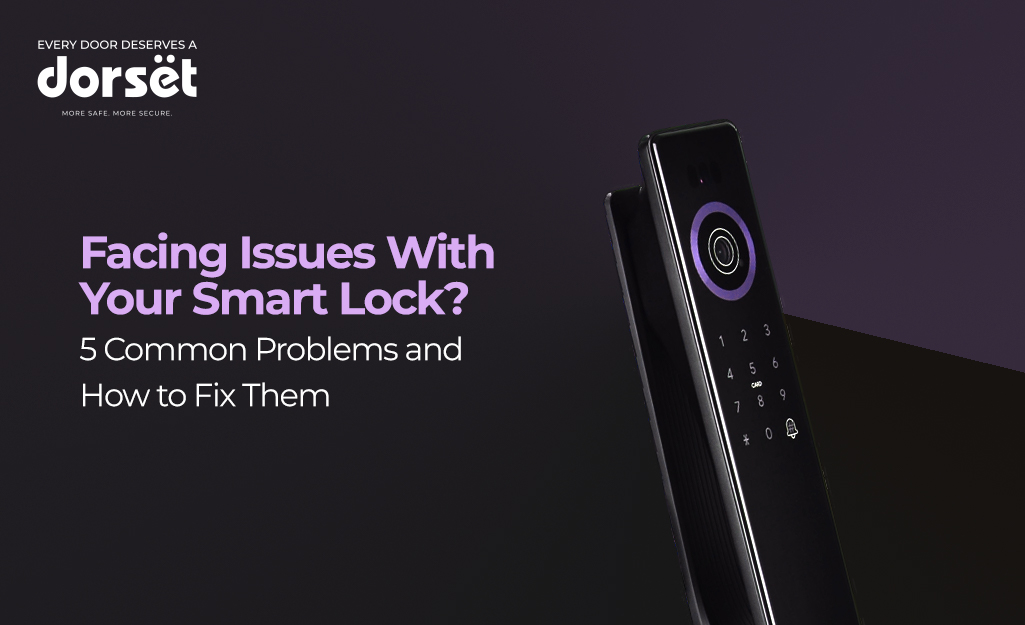Facing Issues With Your Smart Lock? 5 Common Problems and How to Fix Them

Smart locks have really changed the way we think about home security. You can now unlock your door with your phone, a fingerprint, or even a voice command. It’s super convenient. You can even let people in when you’re not home. But like all tech, smart locks aren’t perfect.
Since they mix mechanical parts with electronics, Wi-Fi, and batteries, there are more things that can go wrong compared to regular locks. But don’t worry, once you know what the common problems are, it’s pretty easy to fix most of them and get back to enjoying the ease and safety your smart lock offers.
Problem 1: Battery Drain and Power Issues
One of the most common issues with smart locks is the battery running low too quickly. Most smart locks run on batteries, and these can die out faster than you’d expect especially if the weather’s extreme or if the lock’s being used a lot. You’ll notice it acting slow, not locking or unlocking properly, or showing a low battery warning in the app.
The fix is simple: just replace the batteries with good-quality alkaline or lithium ones, as recommended. Most smart locks even send you a notification when the battery’s low, so don’t ignore that it’s there to save you from getting locked out.
If your lock is placed on a door that gets too much sun or is exposed to cold, it could be draining faster. Try adding a bit of cover or think about switching to a lock that handles weather better.
Some smart locks for home also let you hardwire them or have backup power options. If your battery issues keep happening, check if your lock supports these features. Just remember even hardwired ones usually need backup batteries for power cuts, so don’t skip checking those.
Problem 2: Connectivity and Wi-Fi Problems
Smart locks need a strong internet connection to work well, and when the Wi-Fi acts up, your lock might stop responding to your app or show up as offline.
Start by checking your Wi-Fi signal near the door. Since smart locks are usually installed at the edge of your home’s coverage, they can have weaker signals. You can use your phone to test the strength. If it’s weak, think about adding a Wi-Fi extender or mesh router closer to the entrance.
If your home has a lot of connected devices, the network could be overloaded. This can make it harder for your smart lock to stay online. Try creating a separate network just for smart devices or adjust your router’s settings to give the lock higher priority.
Also, check where your router is placed. If it’s behind walls or near electronics, the signal could be weak. Just moving the router to a better spot can improve your lock’s connection a lot.
Problem 3: App Malfunctions and Software Glitches
Smart locks rely heavily on their apps. If the app crashes, doesn’t connect, or behaves oddly, it can be really frustrating.
First, try the basics: close the app completely and open it again. If that doesn’t work, log out and log back in this can refresh the connection. Also, make sure the app is updated. Updates often fix bugs, improve performance, and add new features.
If you’re on Android, clear the app’s cache and data. On iPhone, try deleting and reinstalling the app. This gives you a fresh start and can fix most stubborn problems. Just remember you might need to sign back in and redo some settings.
Also, check if your lock has a firmware update. Many smart locks for home let you update their software through the app, and it’s a good way to fix bugs and improve how your lock works.
Problem 4: Mechanical Issues and Alignment Problems
Even though smart locks are high-tech, they still use mechanical parts to lock your door. So if something’s misaligned or stuck, it might not lock or unlock properly.
A common issue is door alignment. If your door shifts maybe from weather or loose hinges the lock might not line up with the strike plate. This can cause grinding noises or stop the lock from finishing its cycle.
Check if your door closes smoothly and if the latch fits into the strike plate. If not, you may need to adjust the strike plate or fix any hinge issues. Sometimes, just tightening some screws does the trick.
Also, apply a little graphite lubricant (not oil-based!) to the moving parts to help things slide better. And don’t forget to clean out any dirt or debris that could be jamming the lock.
Problem 5: Keypad and Sensor Issues
If your smart lock has a keypad or fingerprint scanner, you might run into problems where the buttons stop responding or the scanner doesn’t recognize your finger.
For the keypad, it’s usually dirt, moisture, or worn-out buttons causing the problem. Wipe it gently with a slightly damp cloth but don’t let water seep inside. Avoid using any harsh cleaners that could damage the surface.
With fingerprint sensors, clean them with a dry, soft cloth. Oils or dirt on your finger or on the scanner can mess with recognition. If it still doesn’t work, try deleting and re-adding your fingerprints.
Weather can also affect keypads and biometric lock sensors. Cold can make touch screens act weird, and moisture can cause both keypad and fingerprint issues. If your lock is exposed to weather, think about adding a cover or switching to a model made for rough conditions.
When to Call for Professional Help
Most smart lock problems are easy to fix with a little troubleshooting, but sometimes it’s best to call in a pro. If you’re struggling with installation, ongoing connection problems, or mechanical issues that affect how your door locks, a locksmith who knows smart tech can help.
Dorset offers a great range of traditional and smart door locks that are made to last and easy to use. Choosing a trusted brand like Dorset means you also get solid support and regular updates.
Smart locks combine lots of technologies, so a little maintenance and attention go a long way. Keep your app and lock updated, don’t ignore warning signs, and you’ll enjoy the convenience and security they bring. Most issues are totally manageable and well worth the upgrade.
Note: IndiBlogHub features both user-submitted and editorial content. We do not verify third-party contributions. Read our Disclaimer and Privacy Policyfor details.




